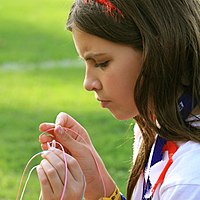
Photo from wikipedia
Understanding others' nonverbal behavior is essential for social interaction, as it allows, among others, to infer mental states. Although gaze communication, a well-established nonverbal social behavior, has shown its importance… Click to show full abstract
Understanding others' nonverbal behavior is essential for social interaction, as it allows, among others, to infer mental states. Although gaze communication, a well-established nonverbal social behavior, has shown its importance in inferring others' mental states, not much is known about the effects of irrelevant gaze signals on cognitive conflict markers during collaborative settings. Here, participants completed a categorization task where they categorized objects based on their color while observing images of a robot. On each trial, participants observed the robot iCub grasping an object from a table and offering it to them to simulate a handover. Once the robot "moved" the object forward, participants were asked to categorize the object according to its color. Before participants were allowed to respond, the robot made a lateral head/gaze shift. The gaze shifts were either congruent or incongruent with the object's color. We expected that incongruent head cues would induce more errors (Study 1), would be associated with more curvature in eye-tracking trajectories (Study 2), and induce larger amplitude in electrophysiological markers of cognitive conflict (Study 3). Results of the three studies show more oculomotor interference as measured in error rates (Study 1), larger curvatures eye-tracking trajectories (Study 2), and higher amplitudes of the N2 ERP of the EEG signals as well as higher event-related spectral perturbation amplitudes (Study 3) for incongruent trials compared with congruent trials. Our findings reveal that behavioral, ocular, and electrophysiological markers can index the influence of irrelevant signals during goal-oriented tasks.
Journal Title: Journal of cognitive neuroscience
Year Published: 2021
Link to full text (if available)
Share on Social Media: Sign Up to like & get
recommendations!